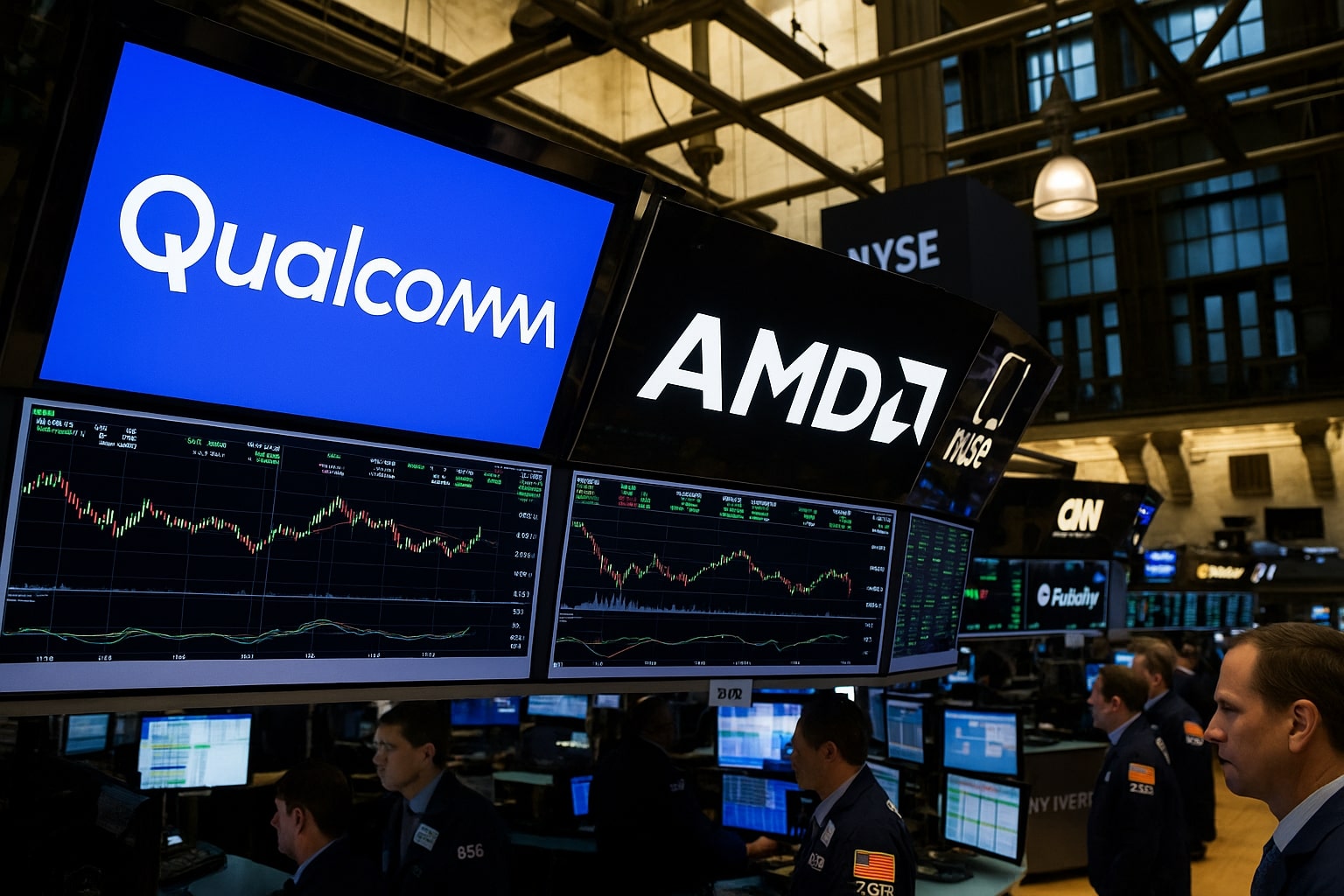
AMD Stock vs Qualcomm Stock: Which Stock Wins the AI Battle at $160?
AMD chases datacenter dominance as Qualcomm leans on mobile and dividends—two different paths with similar price tags but divergent growth outlooks | That's TradingNEWS
AMD vs Qualcomm: Two Distinct AI Strategies Driving Divergent Valuations
NASDAQ:AMD at $159.93 and NASDAQ:QCOM at $160.94 both trade near parity in price, but their businesses, risks, and AI positioning are worlds apart. AMD has surged more than 32% year-to-date, while Qualcomm is up just 6.6% YTD, underperforming the S&P 500’s 12.4% gain. AMD commands a $259 billion market cap, far larger than Qualcomm’s $174 billion, a reflection of investor conviction in AMD’s datacenter GPU roadmap compared to Qualcomm’s slower-moving consumer and handset-driven profile.
Revenue and Growth Profiles
AMD delivered Q2 2025 revenue of $7.7 billion, up 32% year-over-year, with Client segment growth of 67% YoY and Gaming up 73% YoY. Over the trailing twelve months, AMD posted $29.6 billion in revenue, with growth concentrated in its EPYC server and Instinct GPU businesses. Qualcomm, by contrast, generated $43.26 billion in trailing revenue, up 10.3% YoY, heavily supported by handset demand and licensing royalties. Qualcomm’s growth outlook is far more muted, with analysts expecting only 1.9% revenue growth in 2026, compared to AMD’s consensus forecast for 35%+ EPS expansion in the same period.
Profitability and Margins
Qualcomm is significantly more profitable today. Its net margin of 26.8% and operating margin of 26.7% eclipse AMD’s thin 9.6% net margin and -1.3% operating margin, which are pressured by AI-driven R&D. Qualcomm produced $11.6 billion in net income over the last twelve months versus AMD’s $2.7 billion. AMD’s forward profitability, however, is expected to accelerate sharply, with analysts projecting $6.01 EPS in 2026, more than double 2025’s $3.90 EPS. Qualcomm’s EPS outlook is far steadier: $11.90 in 2025 and $12.09 in 2026, showing incremental rather than explosive growth.
Balance Sheet and Cash Flow
AMD holds $5.9 billion in cash and $3.9 billion in debt, giving it net cash flexibility to reinvest in GPU and CPU launches. Free cash flow sits at $2.33 billion. Qualcomm, on the other hand, has $10 billion in cash and $14.8 billion in debt, supported by $5.47 billion in levered free cash flow and $12.66 billion operating cash flow. Qualcomm’s balance sheet leans more leveraged, but its stronger cash generation backs both dividends and buybacks, whereas AMD remains more growth-focused.
Valuation Metrics and Multiples
AMD trades at 95x trailing P/E but compresses to 26.7x forward P/E, highlighting the expected earnings ramp. Its price-to-sales ratio is 8.7x and price-to-book 4.3x, premium multiples relative to peers. Qualcomm, by contrast, trades at just 15.6x trailing P/E and 13.4x forward P/E, with 4.2x price-to-sales and 6.4x price-to-book. Qualcomm offers a far cheaper entry point, but the discount reflects handset cyclicality and Apple’s looming exit.
AI Leadership Divergence
AMD’s growth hinges on datacenter GPUs. The MI355X GPUs are already competing with Nvidia’s B200s, with benchmarks showing superior inference performance on models like Llama3.1. Partnerships with Meta, Microsoft Azure, Oracle, Tesla, and OpenAI reinforce AMD’s AI leadership ambitions. Qualcomm’s AI push is consumer-facing: Snapdragon X Elite PCs, Snapdragon Digital Chassis in autos, and on-device AI integration for mobile platforms. These segments grow quickly, but they lack the trillion-dollar datacenter opportunity Nvidia and AMD are capturing.
Dividends and Shareholder Returns
AMD does not pay a dividend, opting to reinvest heavily in R&D and acquisitions. Qualcomm returns significant capital: its annual dividend of $3.56 per share provides a 2.2% yield, with a payout ratio of 33%, sustainable given cash flows. Qualcomm has also repurchased over 500 million shares in the past decade, reducing float by 31%. For income-focused investors, Qualcomm is clearly more attractive.
Institutional and Insider Dynamics
Institutional ownership is high for both: 69.4% of AMD and 81.3% of QCOM. Short interest in AMD sits at 2.4% of float, compared to Qualcomm’s 1.86%, reflecting relatively neutral sentiment. Insider activity is more relevant to Qualcomm, where insider transactions can influence valuation perceptions. AMD’s insider ownership is just 0.5%, while Qualcomm insiders hold 0.13%, leaving both stocks heavily institutionally controlled.
Read More
-
Pfizer Stock Price Forecast - PFE at $25: Market Prices a Meltdown Into a 7% Yield
19.12.2025 · TradingNEWS ArchiveStocks
-
XRP Price Forecast: XRP-USD Stuck at $1.87 With $3 2026 Target and $10–$25 Long-Term Range
19.12.2025 · TradingNEWS ArchiveCrypto
-
Natural Gas Price Forecast: NG=F Hovering Near $3.92 As Weather, LNG And Storage Collide
19.12.2025 · TradingNEWS ArchiveCommodities
-
Stock Market Today: AI Chip Rally Lifts Nasdaq as $7.1T Quad Witching Hits
19.12.2025 · TradingNEWS ArchiveMarkets
-
USD/JPY Price Forecast - Dollar to Yen Near 157 as BoJ’s 0.75% Rate Hike Backfires on the Yen
19.12.2025 · TradingNEWS ArchiveForex
Technical Outlook
AMD trades above its 50-day moving average of $162.64 but is capped by resistance at $186.65, the 52-week high. Support is near $150 and $140. Qualcomm trades around its 50-day average of $156.42 and above its 200-day average of $155.77, with resistance at $182.10 and downside support at $150. Both stocks are consolidating, but AMD has more momentum after rebounding from $75 lows earlier in 2025, whereas Qualcomm remains range-bound.
Investment View: AMD vs QCOM
AMD offers high growth, premium multiples, and AI-driven upside, with analysts setting targets between $185 and $230, and some bullish calls up to $520 by 2030. Qualcomm provides a value play with steady profitability, dividends, and diversification into autos and IoT, with analyst targets clustered between $178 and $225. Investors chasing explosive AI exposure may prefer NASDAQ:AMD, while those seeking stable cash flows and dividends in a cheaper valuation bracket may lean toward NASDAQ:QCOM.
Verdict:
NASDAQ:AMD – Buy for aggressive growth and AI adoption.
NASDAQ:QCOM – Hold/Buy for value, dividends, and diversification, but tempered by Apple risk.


















